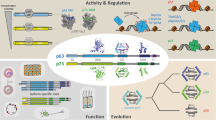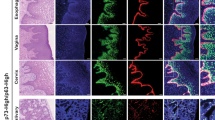Abstract
Since its discovery in 1979, many studies have reported that the p53 tumour suppressor protein could be expressed in the form of products smaller than those predicted by the full-length amino-acid sequence. These products differ from full-length p53 in their N- or C-terminal regions, but generally conserve the central, DNA-binding domain. They appear to be expressed at rather low levels and to be restricted to particular cell types and/or physiological circumstances, suggesting that they play very narrow and specific roles. Several mechanisms have been proposed to explain their timely occurrence, including alternative splicing, internal initiation of translation or proteolytic cleavage. A precise assessment of the various ‘p53 isoforms’ reveals striking similarities with several isoforms of the p53 homologous proteins p63 or p73, suggesting that regulated production of specific, N- or C-terminal variants may be a ‘trademark’ of all family members. In this review, we summarize the published evidence on the structure, mode of production, expression and function of the p53 isoforms, and discuss their properties in the light of recent data on the structure and function of p63/p73 isoforms.
This is a preview of subscription content, access via your institution
Access options
Subscribe to this journal
Receive 50 print issues and online access
$259.00 per year
only $5.18 per issue
Buy this article
- Purchase on Springer Link
- Instant access to full article PDF
Prices may be subject to local taxes which are calculated during checkout


Similar content being viewed by others
References
Ahn J and Prives C . (2001). Nat. Struct. Biol., 8, 730–732.
Almog N, Li R, Peled A, Schwartz D, Wolkowicz R, Goldfinger N, Pei H and Rotter V . (1997). Mol. Cell. Biol., 17, 713–722.
Anderson ME, Woelker B, Reed M, Wang P and Tegtmeyer P . (1997). Mol. Cell. Biol., 17, 6255–6264.
Arai N, Nomura D, Yokota K, Wolf D, Brill E, Shohat O and Rotter V . (1986). Mol. Cell. Biol., 6, 3232–3239.
Ayed A, Mulder FA, Yi GS, Lu Y, Kay LE and Arrowsmith CH . (2001). Nat. Struct. Biol., 8, 756–760.
Barraille P, Chinestra P, Bayard F and Faye JC . (1999). Biochem. Biophys. Res. Commun., 257, 84–88.
Bayle JH, Elenbaas B and Levine AJ . (1995). Proc. Natl. Acad. Sci. USA, 92, 5729–5733.
Blankenship C, Naglich JG, Whaley JM, Seizinger B and Kley N . (1999). Oncogene, 18, 1529–1535.
Brain R and Jenkins JR . (1994). Oncogene, 9, 1775–1780.
Candau R, Scolnick DM, Darpino P, Ying CY, Halazonetis TD and Berger SL . (1997). Oncogene, 15, 807–816.
Chi SW, Ayed A and Arrowsmith CH . (1999). EMBO J., 18, 4438–4445.
Courtois S, Verhaegh G, North S, Luciani MG, Lassus P, Hibner U, Oren M and Hainaut P . (2002). Oncogene, 21, 6722–6728.
De Laurenzi V, Costanzo A, Barcaroli D, Terrinoni A, Falco M, Annicchiarico-Petruzzelli M, Levrero M and Melino G . (1998). J. Exp. Med., 188, 1763–1768.
De Laurenzi VD, Catani MV, Terrinoni A, Corazzari M, Melino G, Costanzo A, Levrero M and Knight RA . (1999). Cell Death Differ., 6, 389–390.
Dohn M, Zhang S and Chen X . (2001). Oncogene, 20, 3193–3205.
Fillippovich I, Sorokina N, Gatei M, Haupt Y, Hobson K, Moallem E, Spring K, Mould M, McGuckin MA, Lavin MF and Khanna KK . (2001). Oncogene, 20, 514–522.
Flaman JM, Waridel F, Estreicher A, Vannier A, Limacher JM, Gilbert D, Iggo R and Frebourg T . (1996). Oncogene, 12, 813–818.
Foulkes NS and Sassone-Corsi P . (1992). Cell, 68, 411–414.
Ghioni P, Bolognese F, Duijf PH, Van Bokhoven H, Mantovani R and Guerrini L . (2002). Mol. Cell. Biol., 22, 8659–8668.
Halazonetis TD and Kandil AN . (1993). EMBO J., 12, 5057–5064.
Han KA and Kulesz-Martin MF . (1992). Nucleic Acids Res., 20, 1979–1981.
Hupp TR, Meek DW, Midgley CA and Lane DP . (1992). Cell, 71, 875–886.
Ishimoto O, Kawahara C, Enjo K, Obinata M, Nukiwa T and Ikawa S . (2002). Cancer Res., 62, 636–641.
Kaghad M, Bonnet H, Yang A, Creancier L, Biscan JC, Valent A, Minty A, Chalon P, Lelias JM, Dumont X, Ferrara P, McKeon F and Caput D . (1997). Cell, 90, 809–819.
Kubbutat MH and Vousden KH . (1997). Mol. Cell. Biol., 17, 460–468.
Kulesz-Martin MF, Lisafeld B, Huang H, Kisiel ND and Lee L . (1994). Mol. Cell. Biol., 14, 1698–1708.
Laverdiere M, Beaudoin J and Lavigueur A . (2000). Nucleic Acids Res., 28, 1489–1497.
Matlashewski G, Pim D, Banks L and Crawford L . (1987). Oncogene Res., 1, 77–85.
May P and May E . (1999). Oncogene, 18, 7621–7636.
Melino G, De LV and Vousden KH . (2002). Nat. Rev. Cancer, 2, 605–615.
Molinari M, Okorokov AL and Milner J . (1996). Oncogene, 13, 2077–2086.
Momand J, Wu HH and Dasgupta G . (2000). Gene, 242, 15–29.
Okorokov AL, Ponchel F and Milner J . (1997). EMBO J., 16, 6008–6017.
Osada M, Ohba M, Kawahara C, Ishioka C, Kanamaru R, Katoh I, Ikawa Y, Nimura Y, Nakagawara A, Obinata M and Ikawa S . (1998). Nat. Med., 4, 839–843.
Ozaki T, Naka M, Takada N, Tada M, Sakiyama S and Nakagawara A . (1999). Cancer Res., 59, 5902–5907.
Pariat M, Carillo S, Molinari M, Salvat C, Debussche L, Bracco L, Milner J and Piechaczyk M . (1997). Mol. Cell. Biol., 17, 2806–2815.
Pozniak CD, Radinovic S, Yang A, McKeon F, Kaplan DR and Miller FD . (2000). Science, 289, 304–306.
Rehberger PA, Richter KH, Schwartz D, Goldfinger N, Oskato R, Almog N, Marks F and Rotter V . (1997). Cell Growth Differ., 8, 851–860.
Sadji-Ouatas Z, Lasfer M, Julien S, Feldmann G and Reyl-Desmars F . (2002). Biochem. J., 364, 881–885.
Scharnhorst V, Dekker P, van der Eb AJ and Jochemsen AG . (1999). J. Biol. Chem., 274, 23456–23462.
Schmale H and Bamberger C . (1997). Oncogene, 15, 1363–1367.
Senoo M, Seki N, Ohira M, Sugano S, Watanabe M, Inuzuka S, Okamoto T, Tachibana M, Tanaka T, Shinkai Y and Kato H . (1998). Biochem. Biophys. Res. Commun., 248, 603–607.
Stiewe T, Zimmermann S, Frilling A, Esche H and Putzer BM . (2002). Cancer Res., 62, 3598–3602.
Thanos CD and Bowie JU . (1999). Protein Sci., 8, 1708–1710.
Trink B, Okami K, Wu L, Sriuranpong V, Jen J and Sidransky D . (1998). Nat. Med., 4, 747–748.
Ueda Y, Hijikata M, Takagi S, Chiba T and Shimotohno K . (1999). Oncogene, 18, 4993–4998.
Unger T, Nau MM, Segal S and Minna JD . (1992). EMBO J., 11, 1383–1390.
Venot C, Maratrat M, Dureuil C, Conseiller E, Bracco L and Debussche L . (1998). EMBO J., 17, 4668–4679.
Venot C, Maratrat M, Sierra V, Conseiller E and Debussche L . (1999). Oncogene, 18, 2405–2410.
Wesierska-Gadek J, Wang ZQ and Schmid G . (1999). Cancer Res., 59, 28–34.
Will K, Warnecke G, Bergmann S and Deppert W . (1995). Nucleic Acids Res., 23, 4023–4028.
Wolf D, Harris N, Goldfinger N and Rotter V . (1985). Mol. Cell. Biol., 5, 127–132.
Wolkowicz R, Peled A, Elkind NB and Rotter V . (1995). Proc. Natl. Acad. Sci. USA, 92, 6842–6846.
Wolkowicz R and Rotter V . (1997). Pathol. Biol. (Paris), 45, 785–796.
Wu Y, Liu Y, Lee L, Miner Z and Kulesz-Martin M . (1994). EMBO J., 13, 4823–4830.
Yang A, Kaghad M, Caput D and McKeon F . (2002). Trends Genet., 18, 90–95.
Yang A, Kaghad M, Wang Y, Gillett E, Fleming MD, Dotsch V, Andrews NC, Caput D and McKeon F . (1998). Mol. Cell, 2, 305–316.
Yin Y, Luciani MG and Fahraeus R . (2002). Nat. Cell Biol., 4, 462–467.
Zhu J, Zhou W, Jiang J and Chen X . (1998). J. Biol. Chem., 273, 13030–13036.
Acknowledgements
We acknowledge Wolfgang Deppert and Moshe Oren for critical reading of the manuscript and suggestions. S Courtois is supported by the European Community Grant QLGI-1999-00273.
Author information
Authors and Affiliations
Corresponding author
Rights and permissions
About this article
Cite this article
Courtois, S., Fromentel, C. & Hainaut, P. p53 protein variants: structural and functional similarities with p63 and p73 isoforms. Oncogene 23, 631–638 (2004). https://doi.org/10.1038/sj.onc.1206929
Received:
Revised:
Accepted:
Published:
Issue Date:
DOI: https://doi.org/10.1038/sj.onc.1206929
Keywords
This article is cited by
-
Functional characterization of GmITPK (myo-inositol: 1, 3, 4 tris phosphate 5/6 kinase) isoforms—‘so different yet so similar’
Journal of Plant Biochemistry and Biotechnology (2019)
-
Protein kinase D inhibitor CRT0066101 suppresses bladder cancer growth in vitro and xenografts via blockade of the cell cycle at G2/M
Cellular and Molecular Life Sciences (2018)
-
Gene expression and splicing alterations analyzed by high throughput RNA sequencing of chronic lymphocytic leukemia specimens
BMC Cancer (2015)
-
Overexpression of p53 protein in human tumors
Medical Molecular Morphology (2012)
-
Novel ARF/p53-independent senescence pathways in cancer repression
Journal of Molecular Medicine (2011)



